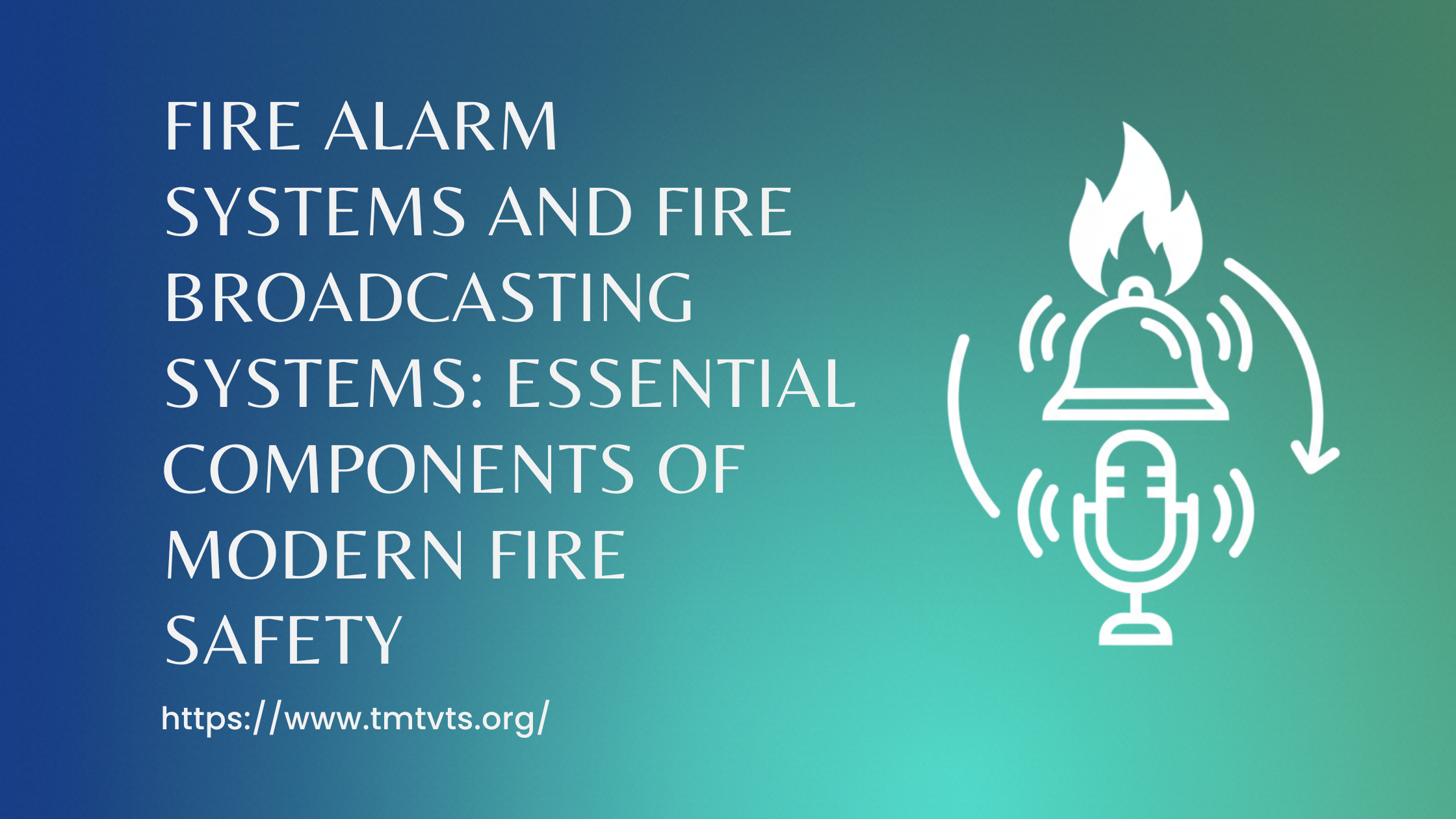When it comes to protecting lives and property from fire hazards, two critical technologies work in tandem: fire alarm systems and fire broadcasting systems. While often confused or considered as one entity, these systems serve distinct yet complementary roles in comprehensive fire safety strategies. Understanding their functions, components, and integration is essential for building managers, safety professionals, and anyone responsible for fire protection.
Fire Alarm Systems: The First Line of Defense
Fire alarm systems are designed to detect fire or fire-related emergencies and alert building occupants to evacuate. These systems have evolved significantly from simple smoke detectors to sophisticated networks that can identify threats early and respond accordingly.
Core Components of Fire Alarm Systems
Detection Devices: Modern fire alarm systems employ various types of detectors, each suited to different environments and fire types:
- Smoke detectors use ionization or photoelectric technology to sense smoke particles
- Heat detectors respond to temperature increases or rapid temperature changes
- Flame detectors identify the infrared or ultraviolet light emitted by flames
- Multi-sensor detectors combine multiple detection methods for improved accuracy
Control Panels: The brain of the system, control panels receive signals from detection devices, process the information, and trigger appropriate responses. Advanced panels can pinpoint the exact location of a fire, display system status, and communicate with other building systems.
Notification Appliances: These devices alert occupants through audible signals (horns, bells, sirens) and visual indicators (strobe lights). Modern systems often incorporate voice evacuation capabilities for clearer communication.
Manual Pull Stations: These allow occupants to manually trigger the alarm when they discover a fire, providing a critical human element to automated detection.
Types of Fire Alarm Systems
Fire alarm systems generally fall into four categories:
Conventional Systems divide buildings into zones, with detectors wired in circuits. When triggered, they indicate which zone has detected fire, though not the specific device location. These are cost-effective for smaller buildings.
Addressable Systems assign unique addresses to each device, allowing the control panel to identify exactly which detector has activated. This precision speeds emergency response and reduces false alarm investigations.
Analog Addressable Systems go further by continuously monitoring environmental conditions and reporting them to the control panel, which determines whether alarm conditions exist based on programmable criteria.
Wireless Systems use radio frequency technology to communicate between devices and the control panel, offering flexibility in historic buildings or locations where running cables is impractical.
Fire Broadcasting Systems: Clear Communication in Crisis
While fire alarm systems detect and alert, fire broadcasting systems (also known as emergency voice communication systems or mass notification systems) provide intelligible voice instructions to building occupants during emergencies. These systems have become increasingly important as research shows that clear, specific voice instructions result in faster, more orderly evacuations than simple alarm tones.
Key Features of Fire Broadcasting Systems
Voice Evacuation: Pre-recorded or live messages can be broadcast throughout a facility, providing specific instructions tailored to the emergency and location. Messages might direct occupants to specific exits, instruct them to shelter in place, or provide other situational guidance.
Zoning Capabilities: Large buildings can be divided into zones, allowing different messages to be broadcast to different areas. For instance, floors nearest the fire might receive immediate evacuation instructions while others receive standby messages.
Priority Messaging: Systems can prioritize emergency messages over normal building announcements, ensuring critical information reaches occupants immediately.
Integration with Detection Systems: When connected to fire alarm systems, broadcasting systems can automatically trigger pre-programmed messages based on the type and location of the detected emergency.
Components of Fire Broadcasting Systems
Amplifiers and Audio Distribution Equipment: These ensure adequate sound pressure levels throughout the building, meeting intelligibility standards even in noisy environments.
Speakers: Strategically placed throughout the facility, speakers must provide clear, understandable audio. Different speaker types suit different environments—ceiling speakers for offices, horn speakers for industrial areas, and weatherproof speakers for outdoor spaces.
Microphone Stations: Allow authorized personnel to broadcast live messages, providing flexibility to address evolving situations.
Message Storage and Playback Devices: Store pre-recorded emergency messages in multiple languages, ensuring diverse populations receive critical information they can understand.
Integration: Creating a Unified Fire Safety System
The true power of fire alarm and broadcasting systems emerges when they’re integrated into a cohesive fire safety network. This integration offers several advantages:
Automated Response: When a fire alarm system detects smoke or fire, it can automatically trigger appropriate voice evacuation messages through the broadcasting system, eliminating delays in notification.
Phased Evacuation: In tall buildings, integrated systems can implement phased evacuation strategies, where the fire floor and adjacent floors evacuate first while other floors receive standby instructions, preventing stairwell congestion.
Two-Way Communication: Some advanced systems include two-way communication capabilities, allowing firefighters to communicate with trapped occupants or coordinate response efforts.
Building System Integration: Modern systems can interface with HVAC systems to control smoke, unlock access control systems to facilitate evacuation, recall elevators, and activate emergency lighting.
Regulatory Compliance and Standards
Fire alarm and broadcasting systems must comply with various codes and standards, which vary by jurisdiction but commonly include:
- NFPA 72 (National Fire Alarm and Signaling Code) in the United States provides comprehensive requirements for fire alarm system design, installation, and maintenance
- Building codes specify where systems are required based on occupancy type, building size, and use
- Intelligibility standards such as the Speech Transmission Index (STI) ensure voice messages are understandable throughout the facility
- ADA requirements mandate visual notification devices to alert hearing-impaired occupants
Maintenance: Keeping Systems Ready
Even the most sophisticated fire safety systems are worthless if they don’t function during an emergency. Regular maintenance is not just good practice—it’s typically required by law:
Testing and Inspection: Systems require regular testing of all components, typically quarterly or annually depending on the device type and local regulations.
Documentation: Maintaining detailed records of inspections, tests, and repairs is essential for regulatory compliance and system reliability.
Battery Backup: All fire safety systems require backup power to function during power outages. Batteries must be tested and replaced according to manufacturer specifications.
Software Updates: Addressable and networked systems may require periodic software updates to maintain functionality and security.
The Future of Fire Safety Technology
Technology continues to advance fire safety systems. Emerging trends include:
Artificial Intelligence: AI-powered analytics can reduce false alarms by better distinguishing between actual fires and benign events like cooking smoke or steam.
Internet of Things (IoT) Integration: Cloud-connected systems enable remote monitoring, predictive maintenance, and real-time notifications to facility managers and emergency services.
Advanced Notification Methods: Some systems now integrate with occupant smartphones, providing personalized evacuation instructions and real-time updates.
Smart Building Integration: Fire safety systems increasingly interface with other building management systems for more coordinated emergency responses.
Conclusion
Fire alarm systems and fire broadcasting systems represent critical investments in life safety. While fire alarm systems provide the essential detection and alert functions, fire broadcasting systems deliver the clear communication necessary for effective emergency response. Together, these technologies form the backbone of modern fire safety strategies, protecting occupants through early detection, timely notification, and clear guidance during emergencies.
For building owners and managers, understanding these systems isn’t just about regulatory compliance—it’s about fulfilling the fundamental responsibility to protect the people who live, work, and visit their facilities. As technology evolves, these systems will become even more sophisticated, but their core mission remains unchanged: detecting danger early and communicating clearly to save lives.





